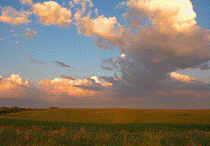North American Prairie Conference
Date of this Version
1989
Abstract
Eastern gamagrass [Tripsacum dactyloides (L.) L.] is currently being selected for higher forage yield. A prolific variant which can produce up to 20 times the number and 3 times the weight of seeds of a normal plant was found in a wild population and is now instrumental in the breeding program. Could this prolific type spread in wild populations? Vegetative vigor of mature plants was assessed by clipping plants to a 7 cm height every two weeks throughout the growing season. The two types did not differ in dry weight of regrowth, suggesting that they tolerate defoliation equally. Seed germination was compared by determining the parentage of 1,043 seedlings emerging near a nursery containing 64% normal and 36% prolific plants. Based on counts of inflorescences and seeds in the soil, variant plants contributed up to 90% of the seeds in the area. However, only 29% of the seedlings established in the area came from prolific plants. The prolific variant was equal in vegetative vigor as an adult plant, and equal or at a disadvantage as a maternal parent. Since the condition is recessive, pollen production is extremely low, and high seed fecundity is offset by poor germination success, the prolific type is not expected to spread in the wild.


Comments
Published in Prairie Pioneers: Ecology, History and Culture: Proceedings of the Eleventh North American Prairie Conference, August 7-11, 1988, Lincoln, Nebraska (Lincoln, NE 1989).